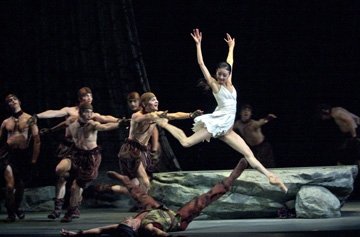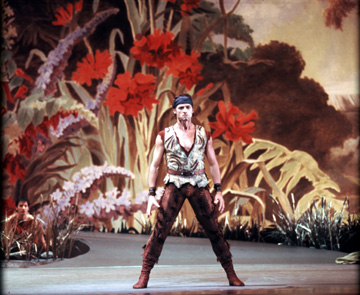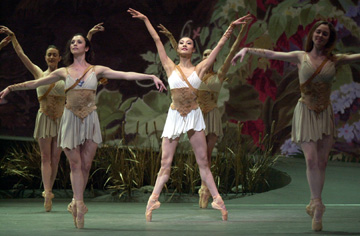A Brilliant Revisionist Sylvia
Sylvia
San
Francisco Ballet
War Memorial Opera House
San Francisco, California
April 30, 2004
by
Ann Murphy
Copyright ©2004 by
Ann Murphy
published May 3, 2004
I loved Sylvia. But is love really the right word? That’s like offering up a gold box with a beautiful ribbon around it with nothing inside. What do I really want to say? That this is a daring, sweet, brilliantly revisionist ballet both important and timely.
 The
marvel of Sylvia is that Morris, Marty Pakledinaz, and Allen
Moyer have lovingly built an exalted but apt vision of the good human
society, one that has to be fought for, as we are all painfully discovering
again. Theirs is a Dionysian-sweet Republic arising from the creaky but
beloved foundations of 19th century Romanticism (where the only good love
is a love that’s dead) and feudalism (equality being something one
can only hope for in the hereafter). In this alternative world, it’s
possible that Siegfried could run away with Odette and settle in Seattle.
Or Giselle could toss her shoes at both Albrecht and Hilarion, side with
Bathilde, then go off and start a guerilla girl dance troupe with Myrtha
and the other Wilis.
The
marvel of Sylvia is that Morris, Marty Pakledinaz, and Allen
Moyer have lovingly built an exalted but apt vision of the good human
society, one that has to be fought for, as we are all painfully discovering
again. Theirs is a Dionysian-sweet Republic arising from the creaky but
beloved foundations of 19th century Romanticism (where the only good love
is a love that’s dead) and feudalism (equality being something one
can only hope for in the hereafter). In this alternative world, it’s
possible that Siegfried could run away with Odette and settle in Seattle.
Or Giselle could toss her shoes at both Albrecht and Hilarion, side with
Bathilde, then go off and start a guerilla girl dance troupe with Myrtha
and the other Wilis.
This is not naïvete, nor do the freedoms come easily. Morris gives us big forces: Eros, Huntress Diana and primitive Orion; love, fertility, pride and war, lust and greed. Oy gevalt do the gods give us trouble—the humans start it, true, but it gets really bad once the gods butt in. Yet, thank god for the gods, because while they make life hell they intercede on our behalf. And when we fight the good fight, love proves more powerful than power, lust or pride combined.
I have a few complaints. In Act 1, the sylvan scene, the dancers looked too green and swampy under James Ingalls’ dark lighting. The stage needs more dappled luminousness both so we can see the dancers' forms better and to give us more of the magical feel of a woodland glade. Those swagged velvet curtains of Moyer’s that replicate the scalloping of the opera house’s gold curtain manage, to my surprise (because I don’t like swagged anything) to encase the action but not suffocate it. (But could someone please tell me what were those rock "beading" hanging down in the cave scene??) And the beautifully woodsy, 60 foot wide backdrop in Act I is beautiful, but also could use more varied light to keep the bright delphinium-like flowers from becoming the sole focal point upstage. The cave was similarly embracing, (although the marbled curtains looked too paint-spattered from the orchestra) and felt rather claustrophobic, but caves are.
Another complaint has to do with the arc of the dance, which has a funny bump in it when Eros rescues Sylvia from the cave. Their return to the glade was accomplished by the drop to the stage floor of the cave drapery, covering up Sylvia and Eros' lower legs, and seeming to enmire them rather than completley free them. The transition would have read better and made more dramatic sense had the cave drapery risen out of the way (I know: how do you then get rid of Orion and his drunken thugs?), placing the two in the woods where they could be saturated with bracing white light.
In any case, from these two womb-like places the switch to a spare pearly and graceful Athenian plaza in Act III was glorious. Through the beautiful costumes and clean pink-white set the designers brilliantly rendered the triumph of love and reason as a sublime yet sensuous victory. I felt as though everyone had ascended to an irridescent Olympian summit, far from John Winthrop’s dour City on a Hill, and there all manner of things were possible. Whoever said being fair or kind can’t be full of beauty and delight?
 And
how did Morris know Yuan Yuan would be a perfect Sylvia? And where did
she dig up that humor? Pairing her with Yuri Possokhov is always a brilliant
choice, because these two combust together, and she acquires personality
nd expressive nuance in the brooding Ukrainian’s presence. She also
softens. While it was no surprise that Tan looked thoroughly at home with
the Amazonian challenges that would face a devotee of Diana, the huntress,
her almost slapstick response to being manhandled and abducted, and then
using her wits to escape was. Not an ounce of self-pity, not a hint of
victimology in this sylph. That’s a heroine young girls can get
their minds around.
And
how did Morris know Yuan Yuan would be a perfect Sylvia? And where did
she dig up that humor? Pairing her with Yuri Possokhov is always a brilliant
choice, because these two combust together, and she acquires personality
nd expressive nuance in the brooding Ukrainian’s presence. She also
softens. While it was no surprise that Tan looked thoroughly at home with
the Amazonian challenges that would face a devotee of Diana, the huntress,
her almost slapstick response to being manhandled and abducted, and then
using her wits to escape was. Not an ounce of self-pity, not a hint of
victimology in this sylph. That’s a heroine young girls can get
their minds around.
Gonzalo Garcia as Aminta was boyishly sweet, especially with echoes of Apollo ringing around him, although he seemed to have a bit of trouble hauling Sylvia (like her Terpshichore) through the air when the time came. But had Morris given the part to a buff, more macho Aminta he would have blurred the distinction with the boorish, greedy but sympathetic Orion, who makes comprehensible the wantonness of our more detestable desires, a la the Big ad Wolf.
Yet it is what Morris does for the whole spectrum of gender that is sublime. The girls are strong and fierce, guys are willing to die for love and in the case of that villager hiding in the bushes, or Aminta lurking behind the rock (a plug for peeping toms?), men are brave through kindness and compassion, not just manly heroics. Girls can dance with girls, guys with guys, and although there is a dominant heterosexual paradigm, preferences are just that: preferences, not moral choices. He gives us a real manly woman in Muriel Maffre’s Diana and a glorious girly guy in Jaime Garcia Castilla’s Eros. Taking off from Morris’ slinky antics in Hard Nut’s Arabian, Eros deliciously personifies the feminine in the man and its transformative power, which is the true source of fecundity and change in Sylvia. It made me think of Shakespeare’s Ariel.
 Morris
makes us hopeful for the future of classical dance. It is hope based on
depth, not the glibness he has relied on at times in the past, and is
evident in the lovely mirroring of scenes and movement (I especially loved
how he let Aminta/Eros be echoed by Sylvia/Orion—he made us see
that Orion’s more bestial desire is linked to loftier love). He
used an array of quotes from the ballet and modern dance canon without
becoming coy or self-conscious, providing a humble nod to his own sources
and giving ballet lovers a deep echo of the masters, from Coralli and
Perrot, to Jooss, Nijinska and Balanchine.
Morris
makes us hopeful for the future of classical dance. It is hope based on
depth, not the glibness he has relied on at times in the past, and is
evident in the lovely mirroring of scenes and movement (I especially loved
how he let Aminta/Eros be echoed by Sylvia/Orion—he made us see
that Orion’s more bestial desire is linked to loftier love). He
used an array of quotes from the ballet and modern dance canon without
becoming coy or self-conscious, providing a humble nod to his own sources
and giving ballet lovers a deep echo of the masters, from Coralli and
Perrot, to Jooss, Nijinska and Balanchine.
At a certain point, locating the quotes was like trying to find the hidden objects in the Highlight books that kept anxiety at bay as I waited to see the dentist as a kid. The very way in which he has Sylvia and Aminta touch finger tip to finger tip like Terpsichore and Apollo, (while discovering each other like Thais and her consort), quoting Balanchine who quotes Michaelangelo, was beautifully transposed here to signify love’s life-giving properties, as well as art and dance’s vitalizing force. His nod to the creepy bellicose politicians in the Green Table or Nijinska’s Bolero were equally lighthanded, equally magical. Putting Sylvia on the cave slab like Nijinska’s Gypsy made me laugh out loud.
But none of that would have mattered if Morris didn’t bear his gifts along on a deep current of poltical, social and moral optimism, taking old forms and transforming them through modernization the way an old still habitable house can be brought up to date with new plumbing, new wiring and the knocking down of a few walls. It is this impulse to conserve but improve that makes him our consummate dance reformer with Sylvia the most brilliant summation of his world view. In benighted times, such vision from artists keeps the light of reason and hope burning.
Photos:
First: Yuan Yuan Tan in Mark Morris' Sylvia (photo courtesy
of SF Ballet)
Second: Yuri Possokhov as Orion in Mark Morris' Sylvia
(photo by Andrea Flores)
Third: Yuan Yuan Tan in Mark Morris' Sylvia (photo courtesy
of SF Ballet)
Originally
published:
www.danceviewtimes.com
Volume 2, Number 16
May 3, 2004
Copyright ©2004 by Ann Murphy
|
|